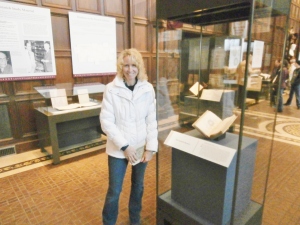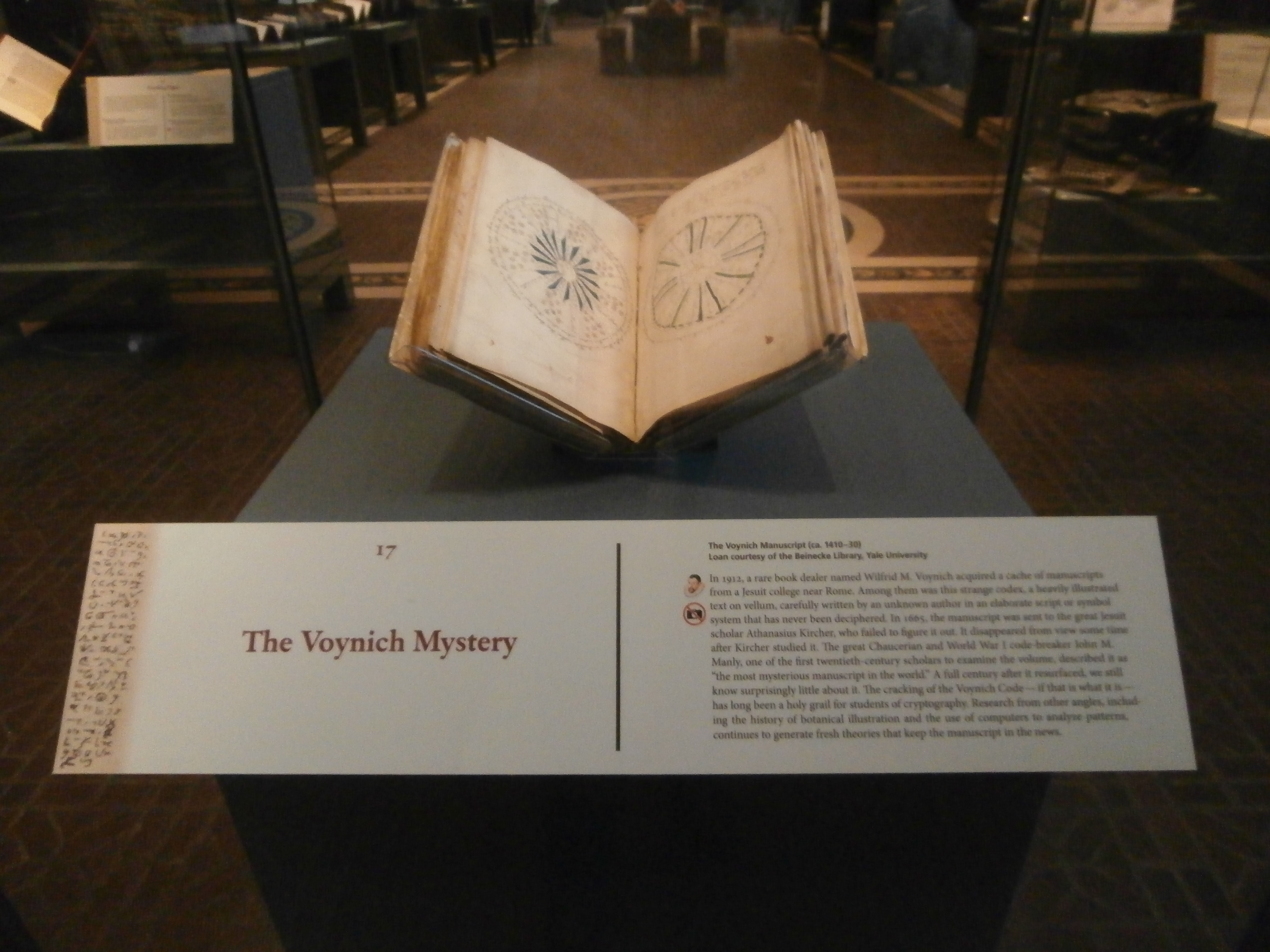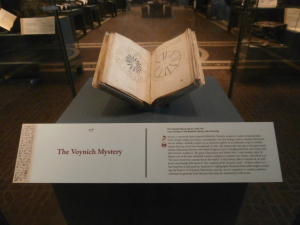 I recently had the wonderful opportunity to go see The Voynich Manuscript on display at the Folger Shakespeare Library in Washington DC. This early 1400’s book is often considered the most mysterious manuscript in the world. It was one, amongst numerous other old spectacular books, concerning the art of codes and ciphers, which were part of an exhibit entitled ‘Decoding the Renaissance’. It was an awesome collection and I had a great time looking over the books.
I recently had the wonderful opportunity to go see The Voynich Manuscript on display at the Folger Shakespeare Library in Washington DC. This early 1400’s book is often considered the most mysterious manuscript in the world. It was one, amongst numerous other old spectacular books, concerning the art of codes and ciphers, which were part of an exhibit entitled ‘Decoding the Renaissance’. It was an awesome collection and I had a great time looking over the books.
The Voynich rested within a showcase near the back of the Great Hall. Other than the guard standing nearby, there wasn’t anything to indicate this particular case held one of the most confounding books of all time. The text wasn’t glowing or it wasn’t hovering inside. 🙂 It looked like the others. It looked like an ordinary old book (which I happen to find amazing too). But it was anything but ‘just that’.
Its 240 elaborate pages of writing is of an unknown script and holds illustrations of unidentifiable plants and images. No one to date has been able to conclusively answer the questions; ‘What does it say?’, ‘What is its purpose?’, or ‘Who wrote it?’
The manuscript is named after the antiquarian book dealer, Wilfred Voynich, who acquired it in 1912. He purchased the strange codex when the Collegio Romano was in need of some money and had contacted him to buy some of their rare books. The manuscript was in a collection of illuminated texts Voynich obtained from them on that occasion.
Voynich immediately began to research the manuscript for clues to its meaning. He had the notion it was written in code by Roger Bacon. If deciphered and proven to hold early inventions of Bacon’s, it would have been worth a small fortune to him. This was never able to be established and a ‘Roger Bacon ownership’ is considered by most to be a false lead today.
Attached to the front of the book, Voynich had discovered a letter dated 1666. It is from this note that much of the manuscript’s history is gained. The letter was from Johannes Marcus Merci (1595-1667) written to Athanasius Kircher (1602-1680). In this letter, Merci is asking Kircher for help in deciphering the manuscript. The note also states the book was an inheritance from a friend (confirmed to be Georg Baresch of Prague) and that it previously belonged to Emperor Rudolf II (1552-1612).
A faint marking noticed in the book gave the name Jacobus de Tepenec and offers another connection to Rudolf II. Because of the pharmaceutical nature of some of the pages in the book, it is assumed Rudolf II’s chief botanist/pharmacist (Jacobus de Tepenec) had the book for some time as well.
This is basically all that is known. Through additional supporting research with the above account, it is believed Rudolf II obtained the book from a currently unknown source. From Rudolf, it passed through a few hands in efforts of decoding it. After Kircher failed to decipher the book and died in 1680, it is assumed it was stored and remained within his papers until Voynich picked it up in 1912. It now (except when on exhibit) is held at Yale University’s Rare Book and Manuscript Library.
What’s missing from this record is its origins. Carbon dating of the manuscript confidently dates the book to the early 1400’s. So the question is asked, where was the book before it makes an appearance in the 1600’s?
With written records for the Manuscript dating back to only Rudolf II’s time, it is the book itself which must relate the rest of its history; and provide us with leads to any additional owners and creator.
So far, it hasn’t relinquished its secrets. The text remains unreadable and indecipherable to all who have tried. And distinguishable clues for determining definite origins are few.
There are various theories, of course.
Expectedly, I suppose, for such a unique and baffling text, but not high on the list of probable, is a theory the manuscript is a work of aliens and emits great power. When I visited the manuscript, I didn’t notice this. However, the guard did say that people were known to lick the glass case it was in, and since I didn’t even touch the case after he informed me of that, this could have been why I left without noticing any amazing alien talent granted to me. 🙂
Nick Pelling, who has taken part on this site in Six Questions feels the Voynich is a coded work by the Italian architect, Filarete. His extraordinary research into Filarete (Antonio Averlino) and the Voynich manuscript is revealed in his book, The Curse of the Voynich. Like I said in Six Questions, Nick’s book is an incredible walk through history of the time. It’s well worth the read.
Another theory suggests it is a 15th century hoax or a nonsensical text created by a ‘Doctor’ trying to persuade clients of his ‘secret knowledge’ for miraculously curing disease. And although this seems a bit extreme, since the creation of the book would have been no easy, simple, inexpensive, or quick task in the making for its day, the text and images are similar to herbal codices of the time. These were used by doctors for medicinal purposes, and so conceivably a ‘doctor’ could have had access to create an impressive fake.
However, from studies done on the manuscript, and the fact that it is such a large and curious piece of work, it is still mainly considered to be a ciphered text waiting to one day be exposed. The time in when it was produced was conducive for such work. New discoveries were being made and needed protected, beliefs were challenging the standards, and fascination into codes and ciphers were creating a science of their own and offering a new way to communicate.
The manuscript continues to remain a mystery and it was exciting to see such an amazing work of history in person. No one knows when or if the text will ever reveal its secrets and I have to say I only skimmed the surface on all its puzzling contents. It is wonderful there is so much mystery yet to explore. Maybe I will talk more on this book another day. Til then,
Best of luck with whatever you seek!



I liked Stephen Bax’s provisional partial decoding https://www.youtube.com/watch?v=fpZD_3D8_WQ.
Thanks so much for the link, Pacman…I’ll be checking it out. I had always found the manuscript interesting and researched it a little, but now after seeing it, I want to study it more. 🙂 It’s such a neat mystery.
Thank-you, Jenny. Great article ( as usual ). Although living close to Washington, DC. I have never been to the Folger Shakespeare Library, so this is now on my list.
Here’s a link to pictures of the manuscript pages (there may be better links, though)
http://www.voynich.nu/folios.html
People lick the glass case ? Never heard that one before, did the guard look like he had a sense of humor, or, was his / her tongue glowing? 🙂
Be Well,
astree
Nice article,
I’m surprised not to have seen more on your site about this previously, but you cant cover everything right!? 🙂
I hope you don’t mind another external link, but there is some great stuff about this too on the following site:
http://www.ciphermysteries.com/?s=voynich
Personally, I suspect it is a ‘hoax’, in the sense it was not done to deceive anyone, or for any gain, but as we would say in 2015…’just for LOl’s’
Dan.
Just noticed your link in the text, I didn’t see it at first read!
🙂
Astree and Danny-boy- I appreciate the added links. There is a lot to research on this book and they are sure to help. So thank you.
(and astree- the guard probably was joking about people licking the case…lol…but I didn’t touch it anyway.)
The whole manuscript can be seen in ordinary or in close-up pictures at the Beinecke Rare Books (Yale) site.
http://brbl-dl.library.yale.edu/vufind/Record/3519597
Awesome Patricia……These comments are making a great resource section. Thanks again all.
If you would like to begin to read the Voynich manuscript, go to http://voynichbirths.blogspot.
Good day!
My name is Nikolai.
To a question about the key to the Voynich manuscript.
Today, I have to add on this matter following.
The manuscript was written no letters, and signs for the letters of the alphabet of one of the ancient languages. Moreover, in the text there are 2 more levels of encryption to virtually eliminate the possibility of computer-assisted translation, even after replacing the signs letters.
I pick up the key by which the first section I was able to read the following words: hemp, hemp clothing; food, food (sheet of 20 numbering on the Internet); cleaned (intestines), knowledge may wish to drink a sugary drink (nectar), maturation (maturity), to consider, to think (sheet 107); drink; six; flourishing; growing; rich; peas; sweet drink nectar and others. It is only a short word, mark 2-3. To translate words consisting of more than 2.3 characters is necessary to know this ancient language.
If you are interested, I am ready to send more detailed information, including scans of pages indicating the translated words.
Sincerely, Nicholas.
Hi Nikolaj,
Sure, I would be interested in hearing more. I’ll send you an email too.
thanks
jenny
Cool! The Voynich Manuscript has always fascinated me. Must have been fun seeing it in person.
I am deciphering the manuscript of Voynich and got positive results.
There is a key to cipher the Voynich manuscript.
The key to the cipher manuscript placed in the manuscript. It is placed throughout the text. Part of the key hints is placed on the sheet 14. With her help was able to translate a few dozen words that are completely relevant to the theme sections.
The Voynich manuscript is not written with letters. It is written in signs. Characters replace the letters of the alphabet one of the ancient language. Moreover, in the text there are 2 levels of encryption. I figured out the key by which the first section could read the following words: hemp, wearing hemp; food, food (sheet 20 at the numbering on the Internet); to clean (gut), knowledge, perhaps the desire, to drink, sweet beverage (nectar), maturation (maturity), to consider, to believe (sheet 107); to drink; six; flourishing; increasing; intense; peas; sweet drink, nectar, etc. Is just the short words, 2-3 sign. To translate words with more than 2-3 characters requires knowledge of this ancient language. The fact that some symbols represent two letters. In the end, the word consisting of three characters can fit up to six letters. Three letters are superfluous. In the end, you need six characters to define the semantic word of three letters. Of course, without knowledge of this language make it very difficult even with a dictionary.
And most important. In the manuscript there is information about “the Holy Grail”.
I’m willing to share information.
Nikolai.